Integrated Metabolomic and Transcriptomic Analyses Reveal the Regulatory Mechanism Underlying the Accumulation of Anthocyanins in Cornus officinalis pericarp
Abstract
:1. Introduction
2. Results
2.1. Phenotypic Characteristics of Cornus officinalis Fruits
2.2. Metabolome Analysis
2.3. KEGG Enrichment of DAMs in Cornus officinalis
2.4. Transcriptome Analysis and Differentially Expressed Gene Identification at Different Stages of Cornus officinalis
2.5. Single-Gene Analysis Related to Anthocyanin Biosynthesis Pathway in Fruit Pericarp
2.6. Transcription Factor Profiling
2.7. Association Analysis of Metabolic and Transcriptomic Data from Cornus officinalis
3. Discussion
3.1. Cyanidin-3-O-glucoside and Pelargonidin-3-O-rutinoside Promote the Red Pigmentation of the Cornus officinalis Pericarp
3.2. Related Regulation of Key Enzymes in Anthocyanin Biosynthetic Pathway
4. Materials and Methods
4.1. Plant Materials
4.2. Microscopic Observation
4.3. Sample Preparation and Extraction
4.4. Metabolome Analysis
4.5. RNA Isolation and Illumina Sequencing
4.6. Transcriptome Data Analysis
4.7. Quantitative Reverse Transcription Polymerase Chain Reaction (qRT-PCR)
4.8. Statistical Methods
5. Conclusions
Supplementary Materials
Author Contributions
Funding
Data Availability Statement
Acknowledgments
Conflicts of Interest
References
- Solfanelli, C.; Poggi, A.; Loreti, E.; Alpi, A.; Perata, P. Sucrose-specific induction of the anthocyanin biosynthetic pathway in Arabidopsis. Plant Physiol. 2006, 140, 637–646. [Google Scholar] [CrossRef] [PubMed]
- Fang, H.C.; Dong, Y.H.; Yue, X.X. The B-box zinc finger protein MdBBX20 integrates anthocyanin accumulation in response to ultraviolet radiation and low temperature. Plant Cell Environ. 2019, 42, 2090–2104. [Google Scholar] [CrossRef] [PubMed]
- Zhang, Q.; Wang, L.L.; Liu, Z.G.; Zhao, Z.H.; Zhao, J.; Wang, Z.T.; Zhou, Z.F.; Liu, P.; Liu, M.G. Transcriptome and metabolome profiling unveil the mechanisms of Ziziphus jujuba Mill. peel coloration. Food Chem. 2020, 312, 125903. [Google Scholar] [CrossRef] [PubMed]
- Colanero, S.; Tagliani, A.; Perata, P.; Gonzali, S. Alternative splicing in the anthocyanin fruit gene encoding an R2R3 MYB transcription factor affects anthocyanin biosynthesis in tomato fruits. Plant Commun. 2020, 1, 100006. [Google Scholar] [CrossRef] [PubMed]
- Sunil, L.; Shetty, N.P. Biosynthesis and regulation of anthocyanin pathway genes. Appl. Microbiol. Biotechnol. 2022, 106, 1783–1798. [Google Scholar] [CrossRef] [PubMed]
- Liu, H.M.; Liu, Z.J.; Wu, Y.; Zheng, L.M.; Zhang, G.F. Regulatory mechanisms of anthocyanin biosynthesis in apple and pear. Int. J. Mol. Sci. 2021, 22, 8441. [Google Scholar] [CrossRef] [PubMed]
- Dubos, C.; Stracke, R.; Grotewold, E.; Weisshaar, B.; Martin, C.; Lepiniec, L. MYB transcription factors in Arabidopsis. Trends Plant Sci. 2010, 15, 573–581. [Google Scholar] [CrossRef] [PubMed]
- Yang, X.H.; Wang, J.R.; Xia, X.Z.; Zhang, Z.Q.; He, J.; Nong, B.X.; Luo, T.P.; Feng, R.; Wu, Y.Y.; Pan, Y.H.; et al. OsTTG1, a WD40 repeat gene, regulates anthocyanin biosynthesis in rice. Plant J. 2021, 107, 198–214. [Google Scholar] [CrossRef]
- Yan, H.L.; Pei, X.N.; Zhang, H.; Li, X.; Zhang, X.X.; Zhao, M.H.; Chiang, V.L.; Sederoff, R.R.; Zhao, X.Y. MYB-Mediated regulation of anthocyanin biosynthesis. Int. J. Mol. Sci. 2021, 22, 3103. [Google Scholar] [CrossRef]
- Chinese Pharmacopoeia Commission. Pharmacopoeia of the People’s Republic of China; China Medical Science and Technology Press: Beijing, China, 2020.
- Ma, J.X. Shennong Bencao Jing Jizhu; People’s Medical Publishing House: Beijing, China, 2013. [Google Scholar]
- Zou, Q.; Wang, T.; Guo, Q.; Yang, F.; Chen, J.; Zhang, W. Combined metabolomic and transcriptomic analysis reveals redirection of the phenylpropanoid metabolic flux in different colored medicinal Chrysanthemum morifolium. Ind. Crop. Prod. 2021, 164, 113343. [Google Scholar] [CrossRef]
- Lou, Q.; Liu, Y.L.; Qi, Y.Y.; Jiao, S.Z.; Tian, F.F.; Jiang, L.; Wang, Y.J. Transcriptome sequencing and metabolite analysis reveals the role of delphinidin metabolism in flower colour in grape hyacinth. J. Exp. Bot. 2014, 65, 3157–3164. [Google Scholar] [CrossRef]
- Li, Y.K.; Fang, J.B.; Qi, X.J.; Lin, M.M.; Zhong, Y.P.; Sun, L.M.; Cui, W. Combined analysis of the fruit metabolome and transcriptome reveals candidate genes involved in flavonoid biosynthesis in actinidia arguta. Int. J. Mol. Sci. 2018, 19, 1471. [Google Scholar] [CrossRef] [PubMed]
- Chen, X.M.; Yan, Y.G.; Zhang, G.; Peng, L.; Wei, Y.; Chen, Y. Effect of different developmental periods on the pattern of fruit quality changes in Cornus officinalis. North. Hortic. 2022, 2, 103–110. [Google Scholar] [CrossRef]
- Yan, S.S.; Chen, N.; Huang, Z.J.; Li, D.J.; Zhi, J.J.; Yu, B.W.; Liu, X.X.; Cao, B.H.; Qiu, Z.K. Anthocyanin fruit encodes an R2R3-MYB transcription factor, SlAN2-like, activating the transcription of SlMYBATV to fine-tune anthocyanin content in tomato fruit. N. Phytol. 2020, 225, 2048–2063. [Google Scholar] [CrossRef] [PubMed]
- Ji, X.L.; Ren, J.; Lang, S.Y.; Wang, D.; Zhu, L.W.; Song, X.S. Differential regulation of anthocyanins in cerasus humilis fruit color revealed by combined transcriptome and metabolome analysis. Forests 2020, 11, 1065. [Google Scholar] [CrossRef]
- Yun, Z.; Juanli, S.; Sylvia, C.; An, J.P.; Andrew, A.C.; Han, Y.P. Colorful hues: Insight into the mechanisms of anthocyanin pigmentation in fruit. Plant Physiol. 2023, 192, 1718–1732. [Google Scholar] [CrossRef] [PubMed]
- Cai, O.; Zhang, H.; Yang, L.; Wu, H.; Qin, M.; Yao, W.; Huang, F.; Li, L.; Lin, S. Integrated Transcriptome and Metabolome Analyses Reveal Bamboo Culm Color Formation Mechanisms Involved in Anthocyanin Biosynthetic in Phyllostachys nigra. Int. J. Mol. Sci. 2024, 25, 1738. [Google Scholar] [CrossRef] [PubMed]
- Zhong, Y.D.; Chen, C.H.; Gong, X.; Luan, X.Y.; Wu, Z.X.; Li, H.H.; Liu, Q.L.; Xu, M.; Yu, F.X. Transcriptome and metabolome analyses reveal a key role of the anthocyanin biosynthetic pathway cascade in the pigmentation of a Cinnamomum camphora red bark mutant (‘Gantong 1’). Ind. Crop. Prod. 2022, 175, 114236. [Google Scholar] [CrossRef]
- Zhao, T.; Wei, Z.; Liu, H.; Dong, L. Integrated Metabolome and Transcriptome Analyses Reveal That the Flavonoid Metabolic Pathway Is Associated with Pigment Differential Accumulation in Two Colors of Petaloid Staminodes in Canna glauca. Horticulturae 2024, 10, 372. [Google Scholar] [CrossRef]
- Shen, Y.; Mao, L.; Zhou, Y.; Sun, Y.; Liu, Z.; Liang, C. Integrated Transcriptome and Metabolome Analysis Revealed the Molecular Mechanism of Anthocyanin Synthesis in Purple Leaf Pepper (Capsicum annuum L.) under Different Light Intensities. Horticulturae 2023, 9, 814. [Google Scholar] [CrossRef]
- Veberic, R.; Slatnar, A.; Bizjak, J.; Stampar, F.; Maja, M.P. Anthocyanin composition of different wild and cultivated berry species. LWT-Food Sci. Technol. 2015, 60, 509–517. [Google Scholar] [CrossRef]
- Feng, X.; Gao, G.; Yu, C.; Zhu, A.; Chen, J.; Chen, K.; Wang, X.; Abubakar, A.S.; Chen, P. Transcriptome and metabolome analysis reveals anthocyanin biosynthesis pathway associated with ramie (Boehmeria nivea (L.) Gaud.) leaf color formation. BMC Genom. 2021, 22, 684. [Google Scholar] [CrossRef] [PubMed]
- Shen, J.; Shao, W.; Du, Z.; Lu, H.; Li, J. Integrated metabolomic and transcriptomic analyses reveal differences in the biosynthetic pathway of anthocyanins in fragaria nilgerrensis and fragaria pentaphylla. Sci. Hortic. 2020, 271, 109476. [Google Scholar] [CrossRef]
- Huang, P.; Lin, F.; Li, B.; Zheng, Y. Hybrid-transcriptome sequencing and associated metabolite analysis reveal putative genes involved in flower color difference in rose mutants. Plants 2019, 8, 267. [Google Scholar] [CrossRef] [PubMed]
- Li, X.; Li, Y.; Zhao, M.; Hu, Y.; Meng, F.; Song, X.; Tigabu, M.; Chiang, V.L.; Sederoff, R.; Ma, W.; et al. Molecular and metabolic insights into anthocyanin biosynthesis for leaf color change in chokecherry (Padus virginiana). Int. J. Mol. Sci. 2021, 22, 10697. [Google Scholar] [CrossRef] [PubMed]
- Bai, S.; Sun, Y.; Qian, M.; Yang, F.; Ni, J.; Tao, R.; Li, L.; Shu, Q.; Zhang, D.; Teng, Y. Transcriptome analysis of bagging-treated red chinese sand pear peels reveals light-responsive pathway functions in anthocyanin accumulation. Sci. Rep. 2017, 7, 63. [Google Scholar] [CrossRef] [PubMed]
- Jaakola, L. New insights into the regulation of anthocyanin biosynthesis in fruits. Trends Plant Sci. 2013, 18, 477–483. [Google Scholar] [CrossRef] [PubMed]
- Kataoka, I.; Sugiyama, A.; Beppu, K. Role of ultraviolet radiation in accumulation of anthocyanin in berries of ‘Gros Colman’ Grapes (Vitis vinifera L.). J. Jpn. Soc. Hortic. Sci. 2003, 72, 1–6. [Google Scholar] [CrossRef]
- Xu, W.L.; Pei, X.L.; Jing, Z.G.; Xiong, Z.L. Genome-wide identification and expression characterization of the chalcone synthase gene family of capsicum annuum. Genom. Appl. Biol. 2015, 34, 1747–1752. [Google Scholar] [CrossRef]
- Himi, E.; Taketa, S. Barley Ant17, encoding flavanone 3-hydroxylase (F3H), is a promising target locus for attaining anthocyanin/proanthocyanidin-free plants without pleiotropic reduction of grain dormancy. Genome 2015, 58, 43–53. [Google Scholar] [CrossRef]
- Li, M.; Wang, Y.H.; Li, C.S.; Hou, L.; Zhao, C.Z.; Xia, H.; Wang, X.J. Cloning and expression analysis of flavanone 3-hydroxylase gene, AhF3H, from Arachis hypogaea L. Shandong Agric. Sci. 2013, 45, 1–6. [Google Scholar] [CrossRef]
- Hall, J.; Ananga, A.; Georgiev, V.; Ochieng, J.; Cebert, E.; Tsolova, V. Molecular cloning, characterization, and expression analysis of Flavanone 3-Hydroxylase (F3H) gene during muscadine grape berry development. J. Biotechnol. Biomater. 2015, 5, 1–7. [Google Scholar] [CrossRef]
- Jiang, F.; Wang, J.; Jia, H.; Jia, W.; Wang, H.; Xiao, M. RNAi-mediated silencing of the Flavanone 3-Hydroxylase gene and its effect on flavonoid biosynthesis in strawberry fruit. J. Plant Growth Regul. 2013, 32, 182–190. [Google Scholar] [CrossRef]
- Qi, X.W.; Shuai, Q.; Fan, L.; Zeng, Q.W.; Xiang, Z.H.; He, N.J. Cloning of mulberry anthocyanin synthase (ANS) gene and its expression characteristics in two fruit-colored mulberry species. Acta Sericologica Sin. 2013, 39, 5–13. [Google Scholar] [CrossRef]
- Sui, X.; Gao, X.; Ao, M.; Wang, Q.; Yang, D.; Wang, M.; Fu, Y.; Wang, L. cDNA cloning and characterization of UDP-glucose: Anthocyanidin 3-O-glucosyltransferase in freesia hybrida. Plant Cell Rep. 2011, 30, 1209–1218. [Google Scholar] [CrossRef] [PubMed]
- Liu, G.Y.; Fang, W.; Yu, C.M.; Lian, B.L.; Chen, Y.H.; Zhong, F.; Zhang, J. Progress in the study of anthocyanin regulation of flower color in plants. J. Anhui Agric. Sci. 2021, 49, 1–4. [Google Scholar] [CrossRef]
- Yonekura-Sakakibara, K.; Fukushima, A.; Nakabayashi, R.; Hanada, K.; Matsuda, F.; Sugawara, S.; Inoue, E.; Kuromori, T.; Ito, T.; Shinozaki, K.; et al. Two glycosyltransferases involved in anthocyanin modification delineated by transcriptome independent component analysis in Arabidopsis thaliana. Plant J. 2012, 69, 154–167. [Google Scholar] [CrossRef] [PubMed]
- Liu, Y.; Ma, K.; Qi, Y.; Lv, G.; Ren, X.; Liu, Z.; Ma, F. Transcriptional Regulation of Anthocyanin Synthesis by MYB-bHLH-WDR Complexes in Kiwifruit (Actinidia chinensis). J. Agric. Food Chem. 2021, 69, 3677–3691. [Google Scholar] [CrossRef] [PubMed]
- Yang, L.; Li, Z.; Li, J.; Ma, Y.; Miao, M.; Long, H.; Zhou, Y.; Chang, W. Integrative Metabolome and Transcriptome Analyses Reveal the Pericarp Coloration Mechanisms in Bitter Melon (Momordica charantia L.). Horticulturae 2024, 10, 291. [Google Scholar] [CrossRef]
- Stracke, R.; Werber, M.; Weisshaar, B. The R2R3-MYB gene family in Arabidopsis thaliana. Curr. Opin. Plant Biol. 2001, 4, 447–456. [Google Scholar] [CrossRef]
- Gonzalez, A.; Zhao, M.; Leavitt, J.M.; Lloyd, A.M. Regulation of the anthocyanin biosynthetic pathway by the TTG1/bHLH/Myb transcriptional complex in Arabidopsis seedlings. Plant J. 2008, 53, 814–827. [Google Scholar] [CrossRef] [PubMed]
- Wu, X.X.; Xue, L.B.; Cha, D.S.; Chen, J.L. Changes in the content of major pigments during the growth and development of colored bell pepper fruits. Southwest China J. Agric. Sci. 2008, 4, 1040–1044. [Google Scholar] [CrossRef]
- Robinson, M.D.; McCarthy, D.J.; Smyth, G.K. edgeR: A bioconductor package for differential expression analysis of digital gene expression data. Bioinformatics 2009, 26, 139–140. [Google Scholar] [CrossRef] [PubMed]
- Livak, K.J.; Schmittgen, T.D. Analysis of relative gene expression data using real-time quantitative PCR and the 2−ΔΔCT method. Methods 2001, 25, 402–408. [Google Scholar] [CrossRef]
- Adnan, M.; Morton, G.; Hadi, S. Analysis of rpoS and bolA gene expression under various stress-induced environments in planktonic and biofilm phase using 2−ΔΔCT method. Mol. Cell Biochem. 2011, 357, 275–282. [Google Scholar] [CrossRef]
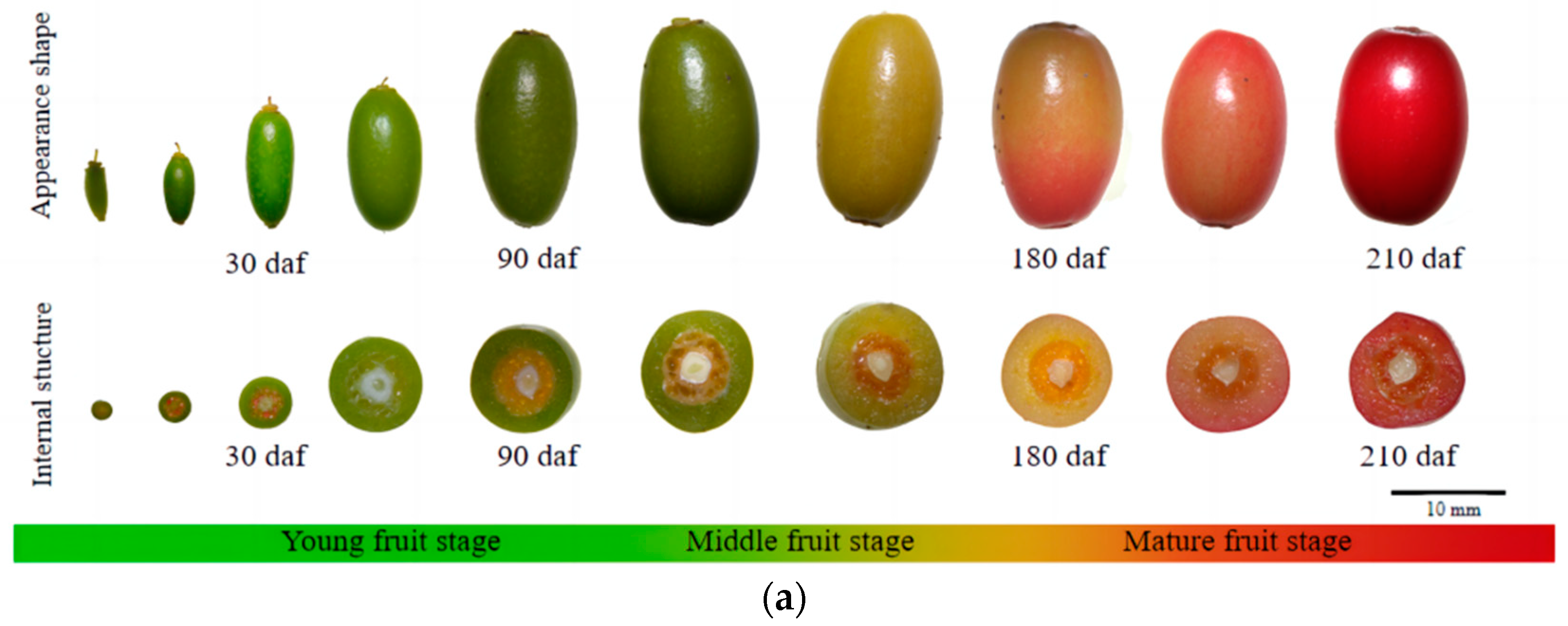

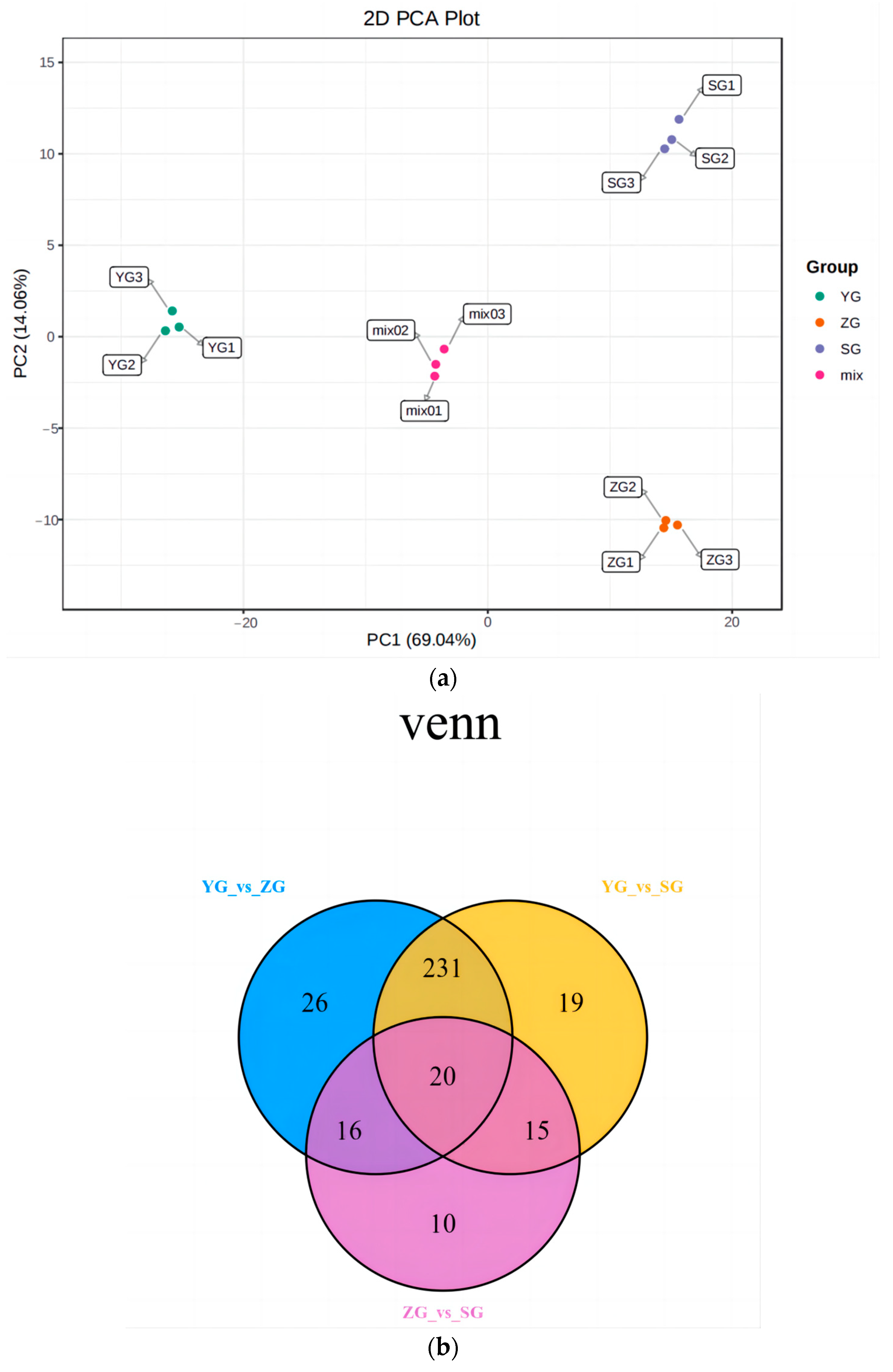
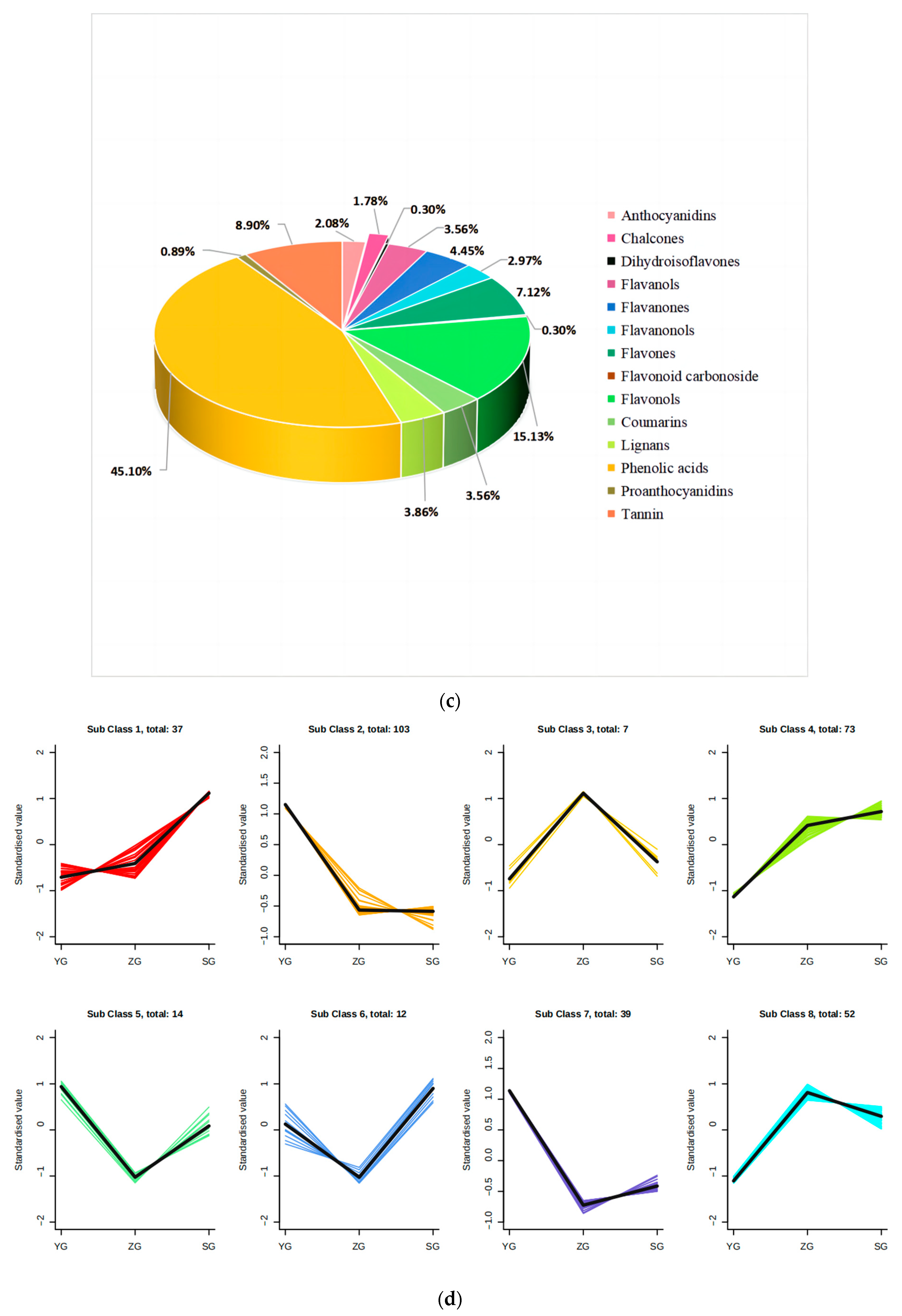

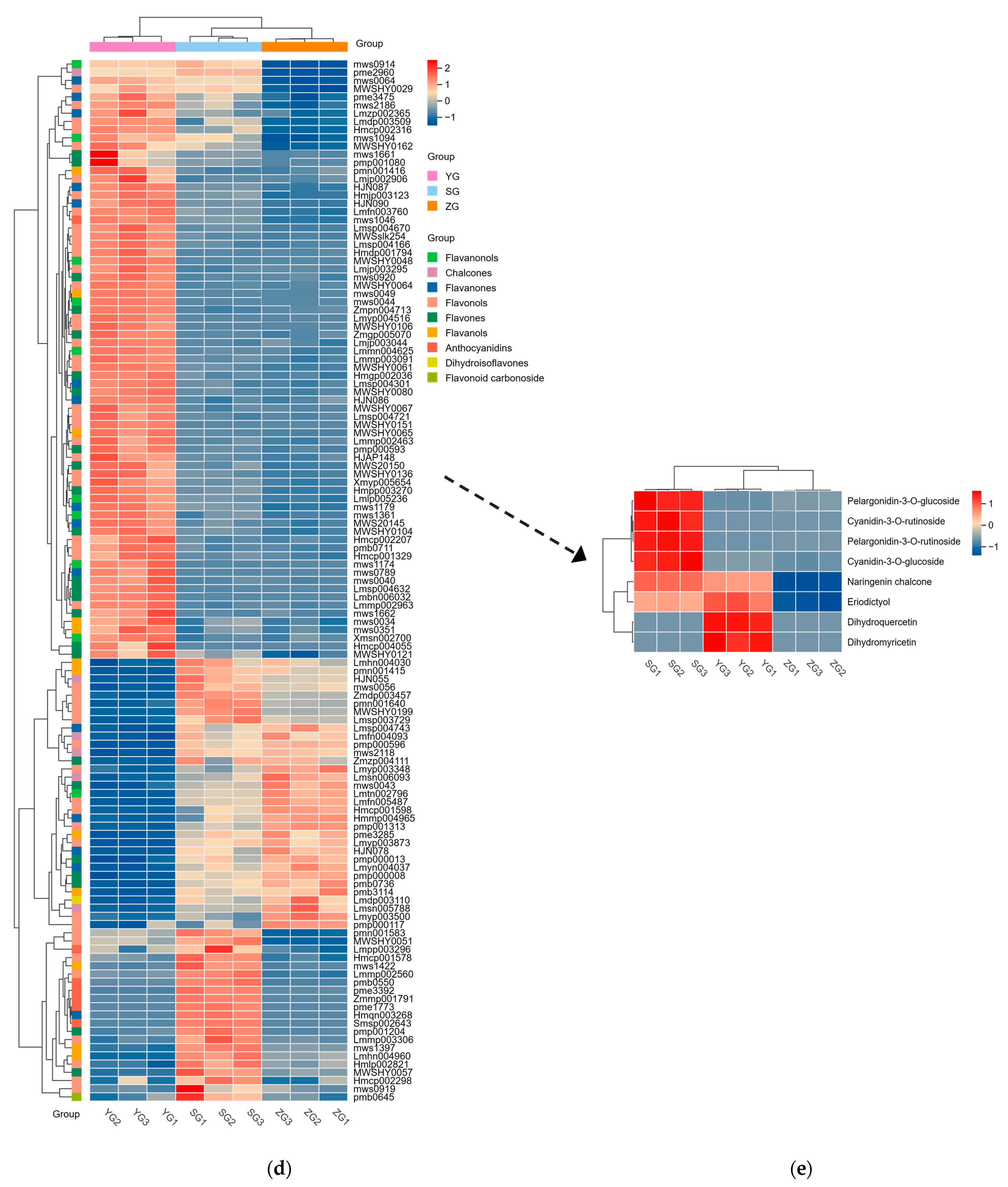





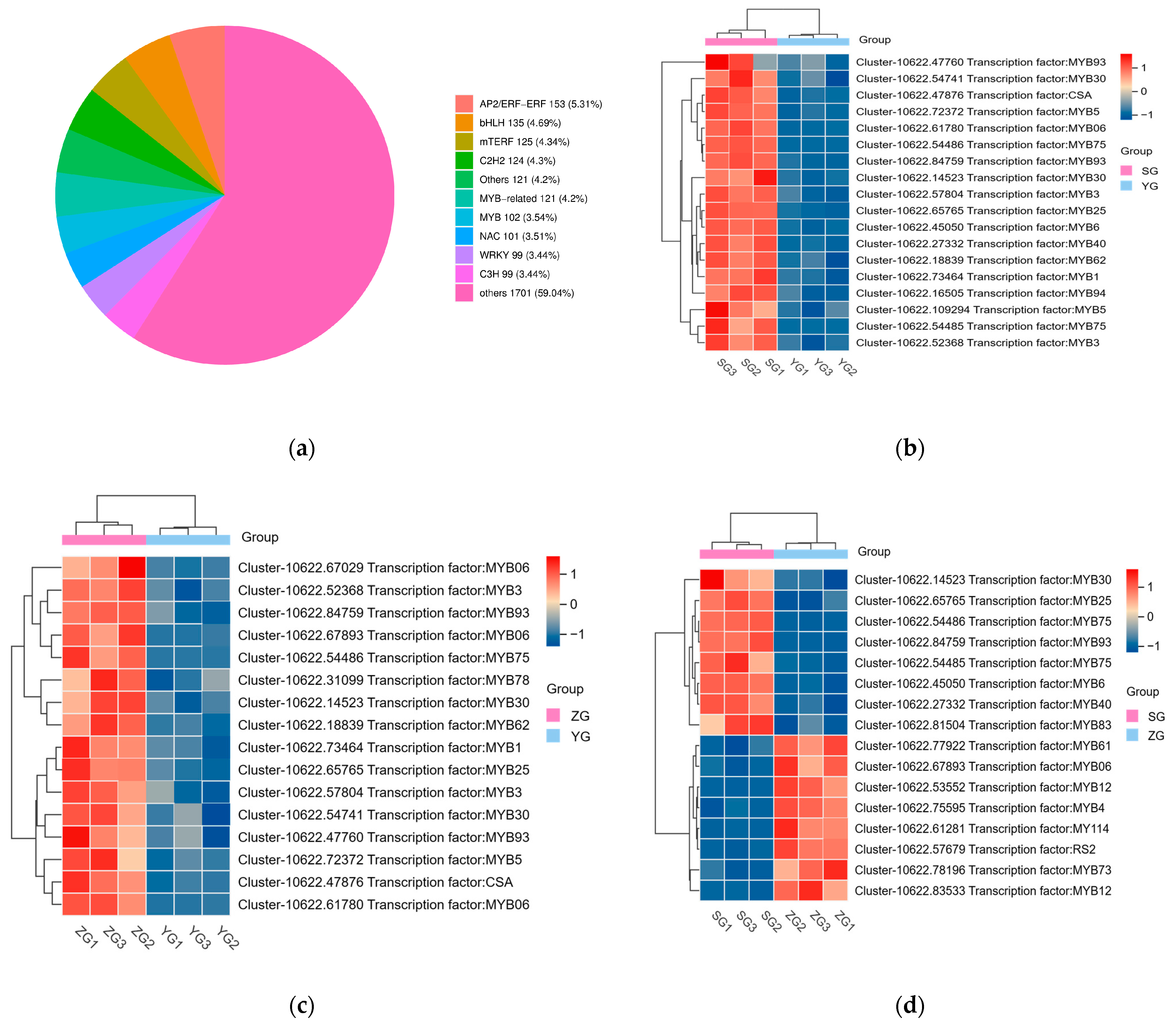

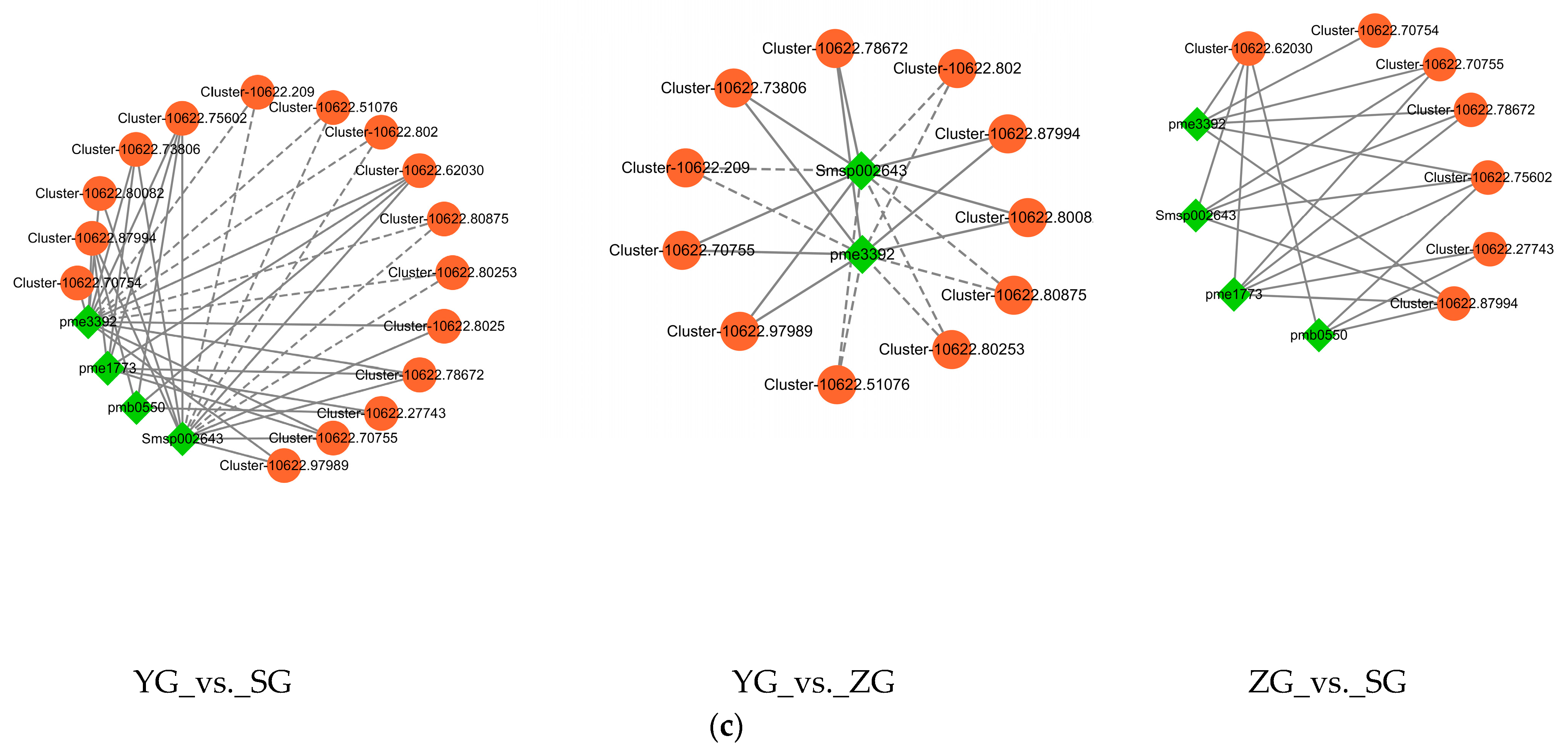
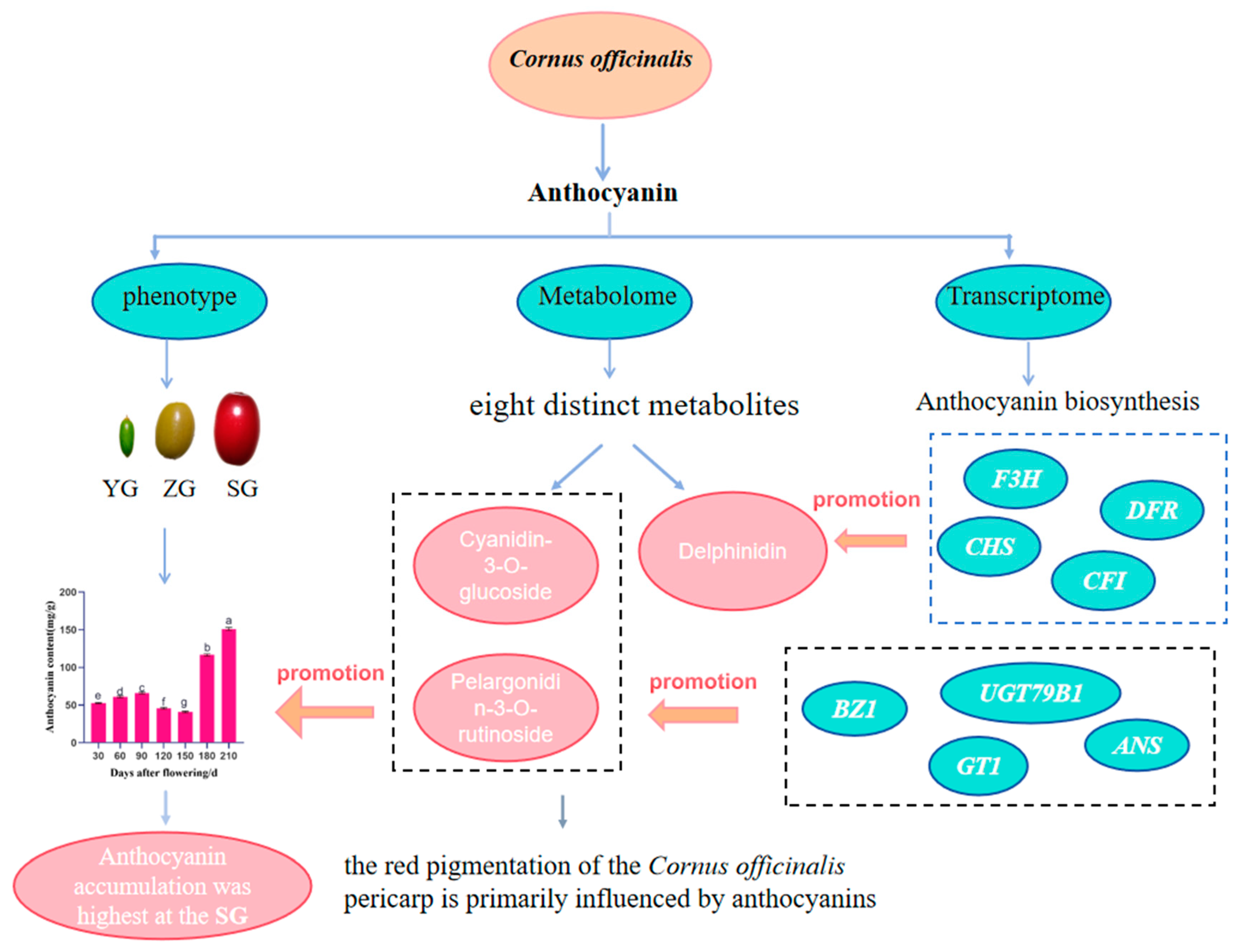
| All_ID | YG_vs._ZG | YG_vs._SG | ZG_vs._SG | KEGG | Swiss-Prot |
|---|---|---|---|---|---|
| Cluster-10622.54486 | TRUE | TRUE | TRUE | K09422 | MYB75 |
| Cluster-10622.84759 | TRUE | TRUE | TRUE | K09422 | MYB93 |
| Cluster-10622.59451 | TRUE | TRUE | TRUE | K09422 | ETC1 |
| Cluster-10622.75595 | TRUE | TRUE | TRUE | K09422 | MYB4 |
| Cluster-10622.83533 | TRUE | TRUE | TRUE | K09422 | MYB12 |
| Cluster-10622.65765 | TRUE | TRUE | TRUE | K09422 | MYB25 |
| Cluster-10622.35824 | TRUE | TRUE | TRUE | K09422 | MYB75 |
| Cluster-10622.53552 | TRUE | TRUE | TRUE | K09422 | MYB12 |
| Cluster-10622.78196 | TRUE | TRUE | TRUE | K09422 | MYB73 |
| Cluster-10622.85424 | TRUE | TRUE | TRUE | K09422 | MYB86 |
| Cluster-10622.89021 | TRUE | TRUE | TRUE | K09422 | ETC1 |
| Cluster-10622.14523 | TRUE | TRUE | TRUE | K09422 | MYB30 |
| Cluster-10622.38334 | TRUE | TRUE | TRUE | K09422 | MYB08 |
Disclaimer/Publisher’s Note: The statements, opinions and data contained in all publications are solely those of the individual author(s) and contributor(s) and not of MDPI and/or the editor(s). MDPI and/or the editor(s) disclaim responsibility for any injury to people or property resulting from any ideas, methods, instructions or products referred to in the content. |
© 2024 by the authors. Licensee MDPI, Basel, Switzerland. This article is an open access article distributed under the terms and conditions of the Creative Commons Attribution (CC BY) license (https://creativecommons.org/licenses/by/4.0/).
Share and Cite
Qin, Y.; Chen, X.; Yang, J.; Gao, J.; Zhang, G.; Yan, Y.; Yang, X.; Zhang, X.; Chen, Y. Integrated Metabolomic and Transcriptomic Analyses Reveal the Regulatory Mechanism Underlying the Accumulation of Anthocyanins in Cornus officinalis pericarp. Horticulturae 2024, 10, 651. https://doi.org/10.3390/horticulturae10060651
Qin Y, Chen X, Yang J, Gao J, Zhang G, Yan Y, Yang X, Zhang X, Chen Y. Integrated Metabolomic and Transcriptomic Analyses Reveal the Regulatory Mechanism Underlying the Accumulation of Anthocyanins in Cornus officinalis pericarp. Horticulturae. 2024; 10(6):651. https://doi.org/10.3390/horticulturae10060651
Chicago/Turabian StyleQin, Yue, Xuanmeng Chen, Jiahui Yang, Jing Gao, Gang Zhang, Yonggang Yan, Xinjie Yang, Xiaofei Zhang, and Ying Chen. 2024. "Integrated Metabolomic and Transcriptomic Analyses Reveal the Regulatory Mechanism Underlying the Accumulation of Anthocyanins in Cornus officinalis pericarp" Horticulturae 10, no. 6: 651. https://doi.org/10.3390/horticulturae10060651





